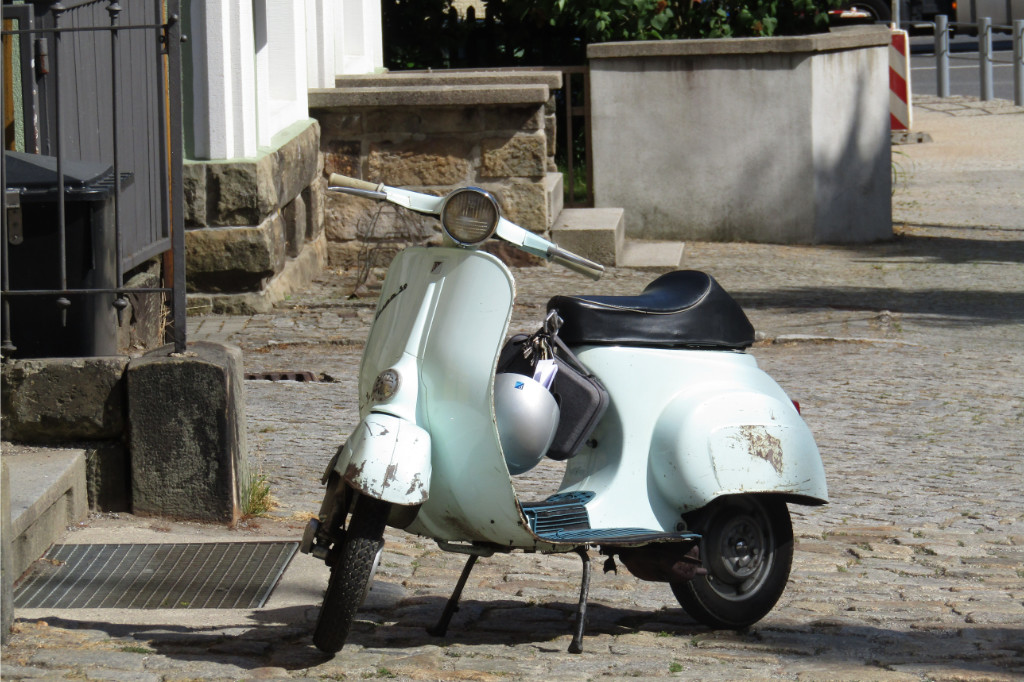The Vespa 50, which has an engine capacity of 50 cm³, is classified as a scooter and was produced by the Piaggio brand in Italy from 1963 to 1990. Because the engine capacity is so small, anyone in Italy who was at least 14 years old was allowed to ride the Vespa 50 without a driving licence. The Vespa 50 thus filled a gap in the market at the time. It is therefore not surprising that it achieved sales figures of more than four million and served as a sales model for manufacturers such as Zündapp and Kreidler. The Vespa 90 was used as the basic model, which is why the Vespa 50 also belongs to the Smallframe range. The main feature of the Vespa 50 is the high level of riding comfort, which is made possible by the large body and the angular shape.
Model variants
Vespa 50 N
It is equipped with simple rubber treads. Its successor is the Vespa 50R. Both models are throttled to 40 km/h and have a brake light, speedometer and type plates in accordance with German registration regulations.
Vespa 50 L
This model was built only for the Italian population. The special features were wing fins and a chrome lamp ring as well as aluminium profile bars with rubber inlay.
Vespa S 50
This model has two handlebar end indicators and a handlebar with round headlights. In addition, the Vespa 50 S can travel at speeds of up to 60km/h. The special models of the Vespa S are the Vespa 50 SS, the Vespa 50 Sprinter and the Vespa 50 SR. The Vespa 50 SS (1965-1971) has a leg shield, mudguards, a short wheelbase and a narrower handlebar. The special feature of this model is a spare wheel and a tool compartment between the handlebar and the seat. The Vespa 50 SS, which can go up to 75 km/h, is also available as the Vespa 90 SS. The Vespa 50 SR (1975-1979) and Vespa 50 Sprinter (1971-1973) both have handlebar end indicators and round headlights on the handlebar. While the Vespa 50 Sprinter has a 50N handlebar and can travel at 68km/h, the Vespa 50 SR has a 125PV handlebar and has a maximum speed of 72km/h.
Vespa 50 Special
This model was also built in different versions. On the one hand it is available with two handlebar end indicators, 6V electrics and double trapezoidal headlights, on the other hand with a 4-way indicator system, 12V electrics, double trapezoidal headlights and a flap at the rear left. The Vespa 50 Specials are also available as an Elestart. In this case, no kick starter is installed, but a Dynastart generator.
Technical data
The engine of the Vespa 50 is based on the larger models as a rotary valve-controlled two-stroke, but the cylinder of this series is inclined at an angle of 45°. Despite the high crankcase volume, the large flywheel mass and the long intake path, the engine’s revving ability and power level remained within limits. The sports versions Vespa 50 S, 50 SS, 50 SR and 50 Sprinter therefore offer more top speed and power. In contrast to the previous model variants, these have a larger carburettor, a different primary gear ratio and a three-channel cylinder.
The frame of the Vespa 50 is much lighter and smaller, as it is spot-welded from sheet metal shells and is self-supporting.
Distribution
Even today, the market for the Vespa 50 is large. Many spare parts can be obtained quickly, as many parts are identical to the Vespa PK and Vespa Ape models. In the meantime, there are also some repair shops that have specialised in the Vespa 50 series. Many collector’s items have a high material value due to the good restoration and repair possibilities.
Cover picture source: Fiver, the psychic, Wikipedia CC BY-SA 4.0



